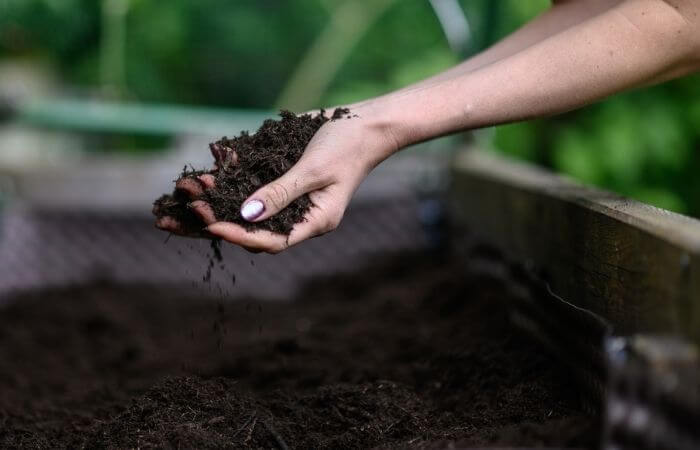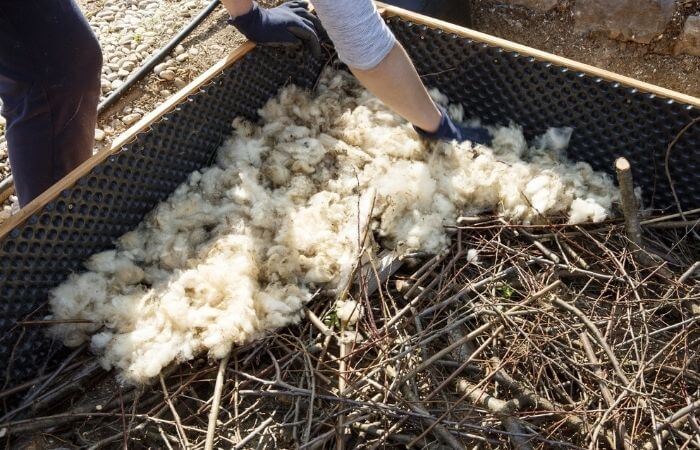Raised-bed gardening is a wonderful way to incorporate flowers, fruits, and vegetables into your home’s landscape. But, many novice gardeners don’t know the right tricks for setting them up and the best way to fill them.
That’s why I’m here to save you time and money by giving you this guide on how to fill a raised garden bed. Inside, you’ll learn how much raised-bed planters cost, the cheapest way to fill them, and the steps to filling them correctly so you can start growing a successful and beautiful garden!

What Do You Fill A Raised Garden Bed With?
The ideal components for a raised garden bed will be a mix of ingredients that supply all the nutrients plants need. The material should create a healthy soil texture that allows for good drainage, aeration, and root development.
For most raised-bed gardens, these are the ingredients you’ll want to start with:
- Topsoil from a garden center
- Compost or composted manure
- Shredded dry leaves
- Coconut coir or peat moss
A balance of six parts topsoil, two parts compost, one part shredded leaves, and one part coconut coir or peat moss should provide a rich mixture.
Topsoil
Topsoil will be the main ingredient in your raised garden bed, but don’t skimp by using dirt from your yard.
Invest in bagged or bulk topsoil from a garden center to ensure the dirt is free of pests, diseases, and weed seeds that could cause headaches as you’re trying to grow plants.
Compost
Compost or manure acts as a slow-release fertilizer for critical plant-growth nutrients such as nitrogen. Compost and manure also introduce beneficial microbes to the soil that help break down minerals for better plant absorption.
The soil in raised beds is prone to drying out faster than in-ground gardens, so the addition of compost also increases moisture retention, which helps reduce watering demands.
Dried Leaves
Mixing in a small amount of dried and shredded leaves will slowly break down in the soil, releasing:
- Nitrogen
- Phosphorus
- Potassium
- Calcium
- Magnesium
- Sulfur
These nutrients, and more, is a natural way to incorporate healthy food matter to the plants inside your raised bed garden.
Leaves also aid in soil aeration and moisture control, as they absorb excess moisture and then release it as the soil dries out.
Coconut Coir Or Peat Moss
Both peat moss and coconut coir are lightweight soil amendments that create air pockets that allow the soil to drain efficiently. These amendments also reduce soil compaction for robust root growth and can hold water to keep the soil moist, but never enough to let the soil get soggy.
When you start your raised garden bed with a quality soil mixture, you’re giving all the plants you put inside a head start on vigorous growth and crop production.
How Much Do Raised Garden Beds Cost?
Pre-made Kits
The cost to purchase a pre-made raised garden bed frame in wood, composite plastic, or metal is all surprisingly affordable. Pre-made options allow you to avoid having to build a raised bed manually and jump right into filling and planting instead.
Most pre-made kits come in a 2-foot wide by 8-foot-long or 4-foot wide by 8-foot long size, but other options, such as 4×4 foot, are available. Most of these kits are only a foot tall, which reduces cost, but may not be as deep as you need for some plants.
DIY Build
For long-lasting construction and custom sizing, hiring out or DIYing a raised garden bed build is best, especially if you have basic tools such as a saw and power drill. The cost will vary depending on materials, such as the thickness of lumber or materials chosen, and whether you need to pay a contractor.
Building a raised garden bed is fairly straightforward, as most make the most use of standard lumber sizes, which reduces waste. DIYers can find a myriad of videos online that provide helpful guidance for construction.
For a 4×8-foot raised bed frame, make sure it includes the wood frame, landscape fabric liner, and screws. Some people choose to use expensive cedar wood over pressure-treated lumber or build higher walls, affecting overall cost.
Cheapest Way To Fill Raised Beds
Before you can fill a raised garden bed cheaply, you need to know how much fill you need. Using a standard length x width x height calculation, you’ll arrive at the cubic feet of material you require.
A standard 8L x 4W x 1H frame holds 32 cubic feet, while the same bed with 2-foot-high sides would hold 64 cubic feet.
While it’s best to fill the bed using bagged or bulk fresh soil, compost, and other amendments, the cost can be expensive for tight budgets. Luckily, you can try these much cheaper methods below.
Using On-site Material

Many home gardeners like to use yard or farm waste as a free filler for raised garden beds, then fill out the rest with depleted soil from potted plants or garden plots. While cheap, the ingredient mixture may not deliver the best base for plant growth.
Hugelkultur Method
The Hugelkultur method reduces the cost of filling a raised garden bed, as it uses rotting logs and large branches as a bulking agent, so less soil is needed.
As the large chunks of material take longer to decompose, this matter will keep your planter full for three to five years before you’ll need to add more soil. This method also benefits raised beds in colder climates, as the decomposition process warms the earth so roots won’t freeze.
Lasagne Method
Like the Hugelkultur method, the lasagne method uses more common yard waste to build up the lower section of the bed before using a minimal amount of topsoil.
In layers three to four inches deep, start at ground level with any size branches from pruned bushes or trees, fallen sticks, and pinecones.
Fill the next layer with leaves or grass clippings, then the next layer with “compost pile” ingredients such as vegetable scraps, coffee grounds, small amounts of shredded cardboard, and used straw from a chicken coop or barn.
Top off the raised garden bed with soil. After each season passes, mix up the top layers of material to refresh the surface’s nutrients.
How To Fill A Raised Garden Bed
Step 1 – Prep The Ground Under The Bed
Till the area underneath your raised garden bed to loosen soil compaction. If your beds are short, this will allow plant roots to grow deep into the underlying soil, creating strong, healthy plants.
Level off the ground around the raised bed’s perimeter, so the framing will lay flat against the surface.
TIP: If the area is grassy, dig up the grass and flip the chunks upside down, killing off the growth while retaining the nutrients.
Step 2 – Line The Bed
I find that my raised beds last longer when I line the sides with a landscape-type fabric that allows air and moisture flow but keeps soil from directly coming in contact with the wood or metal frame.
Using a staple gun, roll out the fabric lengthwise around the inner perimeter and staple along the upper edge. Secure randomly along the bottom edge, so it stays in place as you fill the planter.
There’s no need to cover the ground inside the framing with fabric unless you feel the soil inside may seep out of large gaps or cracks.
Step 3 – Premix Topsoil And Amendments
In a pile or wheelbarrow near the garden bed, dump out qualities of bagged soil and compost ingredients, or use a bucket to measure the correct ratio.
Using a shovel, mix the ingredients well, then add to the bed. Continue to mix and fill until you reach two to four inches from the top of the frame.
Step 4 – Layer And Remove Rocks
As you layer up the soil inside the garden bed, as shown in this video, take the time to lift out any rocks or large chunks that can interfere with root development.
If you opt for the Hugelkultur or Lasagne method, refrain from laying bulky materials more than halfway up the garden bed’s side. You will want six to eight inches of pure soil at the top of the frame in which to set plants.
Step 5 – Water The Soil
Watering down the soil lightly at the end of the filling process helps the ingredients settle into place. If, after watering, you see the soil level is too low, top off the raised bed with additional topsoil.
In Summary
Filling a raised garden bed using any method is simple, but it will take some money, time, and sweat equity to make it happen.
I love the back-saving ease and overall success of growing vegetables and flowers inside my raised garden beds. Give it a try yourself; it’s not that hard, and the results are worth the effort!










